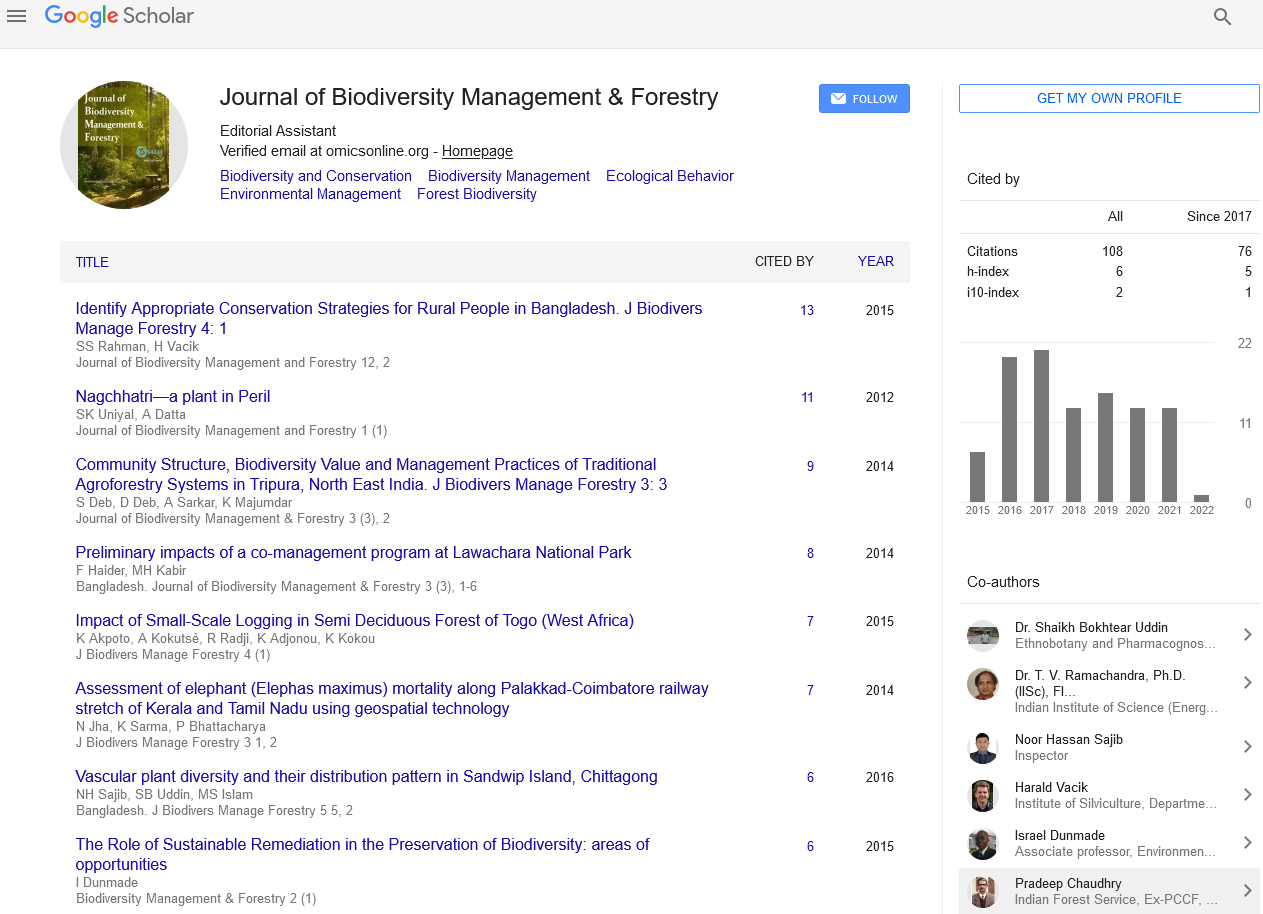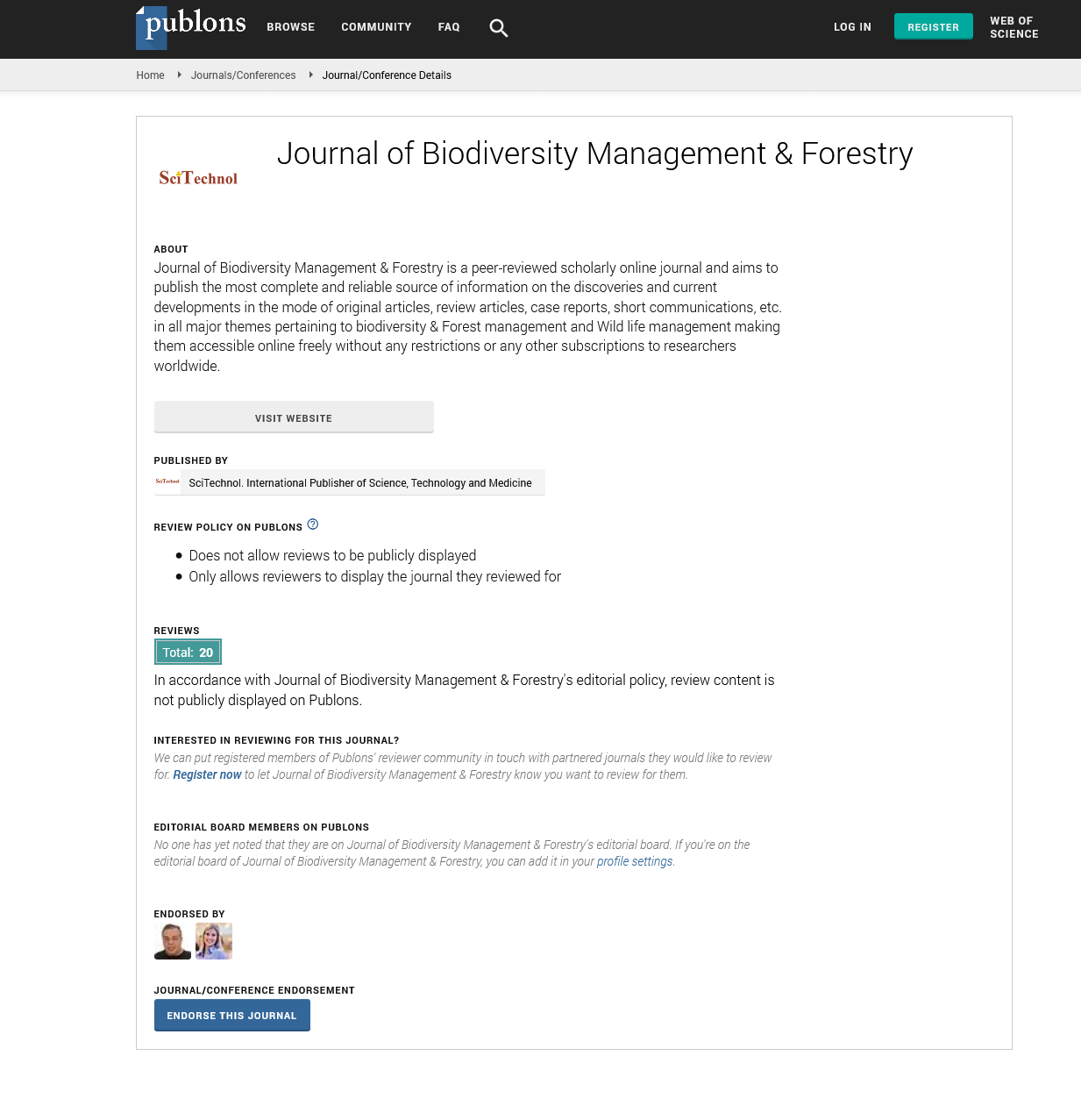Opinion Article, J Biodivers Manage Forestry Vol: 13 Issue: 4
Conserving Endangered Species: Challenges and Solutions
Denise Katrine*
1Department of Molecular Genetics, University of Pittsburgh, Pittsburgh, Pennsylvania, USA
*Corresponding Author: Denise Katrine,
Department of Molecular Genetics, University
of Pittsburgh, Pittsburgh, Pennsylvania, USA
E-mail: denise.katrine@asmusa.org
Received date: 25 November, 2024, Manuscript No. JBMF-24-154565;
Editor assigned date: 27 November, 2024, Pre QC No. JBMF-24-154565 (PQ);
Reviewed date: 11 December, 2024, QC No. JBMF-24-154565;
Revised date: 19 December, 2024, Manuscript No. JBMF-24-154565 (R);
Published date: 27 December, 2024, DOI: 10.4172/jbmf 2327-4417.1000068.
Citation: Katrine D (2024) Conserving Endangered Species: Challenges and Solutions. J Biodivers Manage Forestry 13:4.
Description
Biodiversity is the foundation of life on Earth, providing essential ecological services and contributing to the flexibility of ecosystems. However, the survival of many species is under threat due to human activities, environmental changes and natural factors. Endangered species, those at risk of extinction, require immediate attention and coordinated efforts for their conservation. This study discuss the challenges associated with conserving endangered species and outlines practical solutions to address these issues. The destruction of natural habitats is the leading cause of species endangerment. Urbanization, deforestation, mining and agricultural expansion reduce the availability of habitats for wildlife. For example, the clearing of rainforests has significantly impacted species such as orangutans and jaguars, displacing them from their natural environments.
Global warming alters ecosystems and forces species to adapt, migrate, or perish. Changes in temperature, precipitation patterns and sea levels disrupt breeding cycles, food availability and migration routes. Polar bears, for instance, face diminishing ice habitats, threatening their survival. Pollution, including plastic waste, oil spills and chemical runoff, contaminates ecosystems. Marine species like sea turtles often ingest plastics, mistaking them for food, leading to injury or death. Similarly, air and soil pollution affect terrestrial species, reducing reproductive rates and increasing mortality. Poaching for fur, ivory and traditional medicines contributes to the decline of species such as elephants, rhinoceroses and pangolins. The illegal wildlife trade is a multi-billion-dollar industry that not only endangers species but also destabilizes ecosystems. The introduction of non-native species disrupts local ecosystems by outcompeting, preying on, or introducing diseases to native species. For instance, the brown tree snake has caused significant declines in bird populations in Guam. Conservation efforts often require substantial financial investment, which is not always available. Developing countries, in particular, face challenges in allocating resources for biodiversity protection amidst competing priorities like poverty alleviation and infrastructure development. Reforestation, wetland rehabilitation and coral reef restoration can help rebuild ecosystems and provide habitats for endangered species.
Restoration projects, like the Great Green Wall initiative in Africa, aim to restore degraded landscapes, benefiting both biodiversity and local communities. Enforcing stricter laws against poaching, illegal trade and habitat destruction is important. International agreements like the Convention on International Trade in Endangered Species (CITES) regulate trade in wildlife products and protect species from exploitation. Empowering local communities to participate in conservation efforts is essential. Community-based conservation programs, such as the Maasai Mara Conservancies in Kenya, involve locals in protecting wildlife while providing economic benefits through ecotourism. Reducing climate change through renewable energy adoption, reducing greenhouse gas emissions and reforestation helps protect species vulnerable to global warming. Adaptive strategies, like creating migration corridors, enable species to move to suitable habitats as climates shift. Preventing the introduction of invasive species through stringent biosecurity measures and eradicating existing invasive populations are vital steps. For example, the removal of invasive goats from the Galápagos Islands has allowed native plants and animals to recover. Captive breeding programs help boost population numbers of captious endangered species. For instance, the California condor was brought back from the brink of extinction through captive breeding and reintroduction efforts. Ongoing research is essential for understanding species' needs, threats and responses to conservation strategies.
Technologies like satellite tracking and genetic studies provide valuable data for effective management. Offering financial incentives, such as carbon credits and payments for ecosystem services, encourages individuals and businesses to prioritize conservation. For example, initiatives that pay farmers to maintain biodiversity-friendly practices support species preservation while promoting sustainable livelihoods. Conserving endangered species is a complex and multifaceted challenge requiring global cooperation and commitment. Addressing habitat destruction, climate change, pollution and other threats involves a combination of legal, scientific and communitydriven approaches. Successful conservation initiatives demonstrate that with adequate resources, innovative strategies and public support, it is possible to reverse the decline of endangered species and ensure the health of ecosystems for future generations. The urgency to act is clear: the preservation of biodiversity is not just about saving individual species, but about sustaining the delicate balance of life on Earth.
 Spanish
Spanish  Chinese
Chinese  Russian
Russian  German
German  French
French  Japanese
Japanese  Portuguese
Portuguese  Hindi
Hindi 
